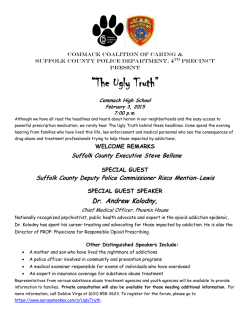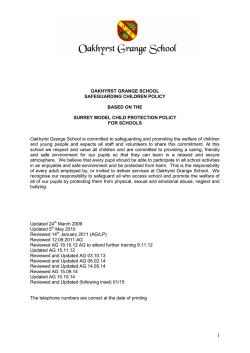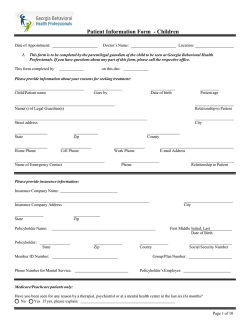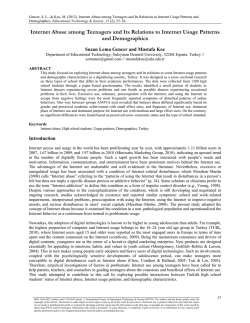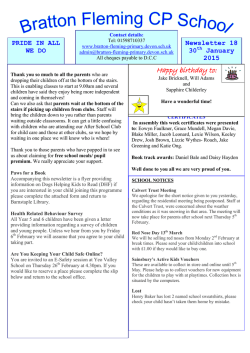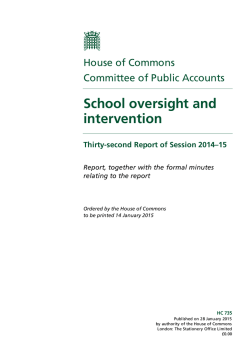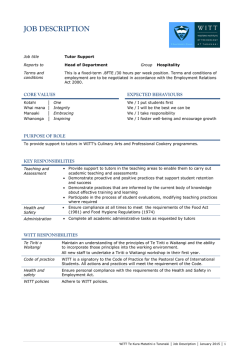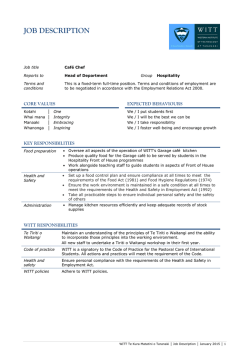
View/download document (496KB) - Goostrey Pre
lre
Goostrey Pre-School
Safeguarding children and child
L:¡
{
i.
-"
\;/
protection
g-
(lnctuding managing allegations of abuse against a member of
staff)
Goostrey Pre-School's Safeguarding officer: Rachel Boulton
Policy statement
Goostrey Pre-Schoot witt work with chitdren, parents and the community to ensure
the rights and safety of children and to give them the very best start in [ife. Our
Safeguarding Policy
is based on the three key commitments of the
Pre-school
Learning A[tiance Safeguarding Chitdren Poticy.
Procedures
to
we meet the three
key
to buitding a 'culture of safety' in which children
are
We carry out the foltowing procedures
ensure
commitments of the Alliance
Safeguarding Chitdren Poticy.
Key commitment I
The Attiance is committed
protected from abuse and harm in att areas of its service detivery.
StaÍl and volunteers
.
Our designated person (a member
of staff) who co-ordinates
child
of the management team)
who
protection issues is: Rachel Boutton
.
Our designated officer (a member
oversees this work is: Katie Saunders (Chair of committee)
.
We ensure all staff are trained
to understand our safeguarding poticies
and procedures and that parents are made aware of them too.
o
A[[ staff have an up-to-date knowledge of safeguarding issues.
o
We provide adequate and appropriate staffing resources to meet the
needs of chitdren.
.
Appticants
for
posts within
the setting are ctearty informed that the
positions are exempt from the Rehabilitation of Offenders Act 1974.
.
Candidates are informed
of the need to carry out 'enhanced disctosure'
checks with the Criminat Records Bureau before posts can be confirmed.
o
Where applications are rejected because of obtaining information that
has been disctosed, appticants have the right
to know and to chatlenge
incorrect information.
o
We abide by Ofsted requirements in respect of references and Criminal
for staff and votunteers, to ensure that no
person or unsuitable person works at the setting or has
Record Bureau checks
disquatified
access
o
.
to the children.
Votunteers do not work unsupervised.
We record information about staff quatifications, and the identity checks
and vetting processes that have been completed inctuding:
o
o
o
.
the criminal records disctosure reference number;
the date the disclosure was obtained; and
details of who obtained it.
We inform all staff that they are expected to disctose any convictions,
or reprimands and warnings which may affect
their suitabitity to work with chitdren (whether received before or
cautions, court orders
during their employment with us).
. We abide by the Safeguarding Vutnerable Groups Act (2006)
requirements
in
respect
of any person who is dismissed from our
emptoyment, or resigns in circumstances that woutd otherwise have led
to dismissal for reasons of a child protection concern.
o
o
We have procedures for recording the details of visitors to the setting.
We take security steps to ensure that we have control over who comes
into the setting so that no unauthorised person has unsupervised access
to the children.
o
We take steps to ensure children are not photographed or fitmed on
video for any other purpose than
to record their
devetopment or their
participation in events organised by us. Parents sign a consent form and
have access
to records holding visual images of their chitd.
Key commitment 2
The Attiance is committed
to
responding promptty and appropriatety
to
att
incidents or concerns of abuse that may occur and to work with statutory agencies
in accordance with the procedures that are set down in 'What to do if you're
worried a chitd is being abused' (HMG 2006).
Respondìng
.
to suspicions of abuse
We acknowtedge that abuse of children can take different forms - physical,
emotionat, and sexual,
.
as
welt as neglect.
When children are suffering from physicat, sexual or emotional abuse, or
experiencing neglect, this may be demonstrated through:
-
significant changes in their behaviour;
deterioration in their generat well-being;
their comments which may give cause for concern, or the things they
say
(direct or indirect
.
disctosure);
changes in their appearance, their behaviour, or their play;
unexptained bruising, marks or signs of possibte abuse or negtect; and
any reason to suspect negtect or abuse outside the setting.
We take into account factors affecting parental capacity, such as social
exctusion, domestic violence, parent's drug
or atcohol abuse, mental
or
physicat illness or parent's learning disabitity.
.
We are aware of other factors that affect children's vutnerabitity such as,
abuse of disabted chitdren; fabricated or induced ittness; chitd abuse tinked
to betiefs in spirit
possession; sexual exptoitation
of children, such as
through internet abuse; and Femate Genital Mutitation; that may affect, or
may have affected, children and young people using our provision.
.
We also make oursetves aware that some chitdren and young peopte are
affected by gang activity, by comptex, muttiple or organised abuse, through
forced marriage or honour based viotence or may be victims of chitd
trafficking. White this may be less tikety to affect young chitdren in our
care, we may become aware of any of these factors affecting otder chitdren
and young people who we may come into contact with.
a
Where we betieve that a chitd in our care or that is known
of
affected by any
to us may be
these factors we follow the procedures betow for
reporting chitd protection concerns.
a
Where such evidence is apparent, the chitd's key person makes a dated
record
of the details of the concern and discusses what to do with the
member of staff who is acting as the 'designated person'. The information is
stored on the chitd's personat file.
a
We refer concerns to the [oca[ authority children's social care department
and co-operate futty in any subsequent investigation. NB In some cases this
may mean the potice or another agency identified by the Local Safeguarding
Chitdren Board.
a
We take care not to influence the outcome either through the way we speak
to chitdren or by asking questions of children.
o
We take account of the need to protect young peopte aged 16-19 as defined
by the Children Act 1989. This may inctude students or school chitdren on
work ptacement, young employees or young parents. Where abuse is
suspected we fotlow the procedure for reporting any other chitd protection
concerns. The views of the young person wilt always be taken into account,
but the setting may override the young person's refusal to consent to share
information
if it
feets that
it is necessary to prevent
a crime from being
committed or intervene where one may have been, or to prevent harm to
a
chitd or adutt. Sharing confidential information without consent is done only
where not sharing
it coutd
be worse than the outcome of having shared
it.
Recording suspícions of abuse and disclosures
.
Where a chitd makes comments
to a member of staff that give cause for
concern (disctosure), or a member of staff observes signs or signats that give
cause for concern, such as significant changes in behaviour; deterioration in
general wett-being; unexptained bruising, marks or signs of possible abuse or
negtect; that member of staff:
listens to the child, offers reassurance and gives assurance that she or he
witl take action;
does not question the chitd;
makes a written record that forms an objective record of the observation or
disctosure
that includes: the date and time of the observation or
the
disctosure; the exact words spoken by the chitd as far as possibte; the name
of the person to whom the concern was reported, with the date and time;
and the names of any other person present at the time.
These records are signed and dated and kept securety and confidentiatty.
The member of staff acting as the 'designated person' is informed of the
issue at the eartiest opportunity.
Where
the Local Safeguarding Chitdren Board stipulates the
process for
recording and sharing concerns, we inctude those procedures atongside this
procedure and foltow the steps set down by the Locat Safeguarding Chitdren
Board.
tÁaking a
referral to the local authoríty children's social core team
. The Pre-schoot Learning Atliance's publication Safeguarding Children
contains procedures for making a referral to the local chitdren's sociat care
team, as wett as a template form for recording concerns and making a
referral. This is based on 'What to do if you're worried a chitd is being
abused' (HMG 2006).
o
We keep a copy of this document alongside the procedures for recording and
reporting set down by our Locat Safeguarding Chitdren Board, which we
fotlow where locat procedures differ from those of the Pre-school Learning
Atliance.
lnforming parents
.
Parents are normatty the
first point of contact. We discuss concerns with
parents to gain their view of events, untess we feel this may put the chitd in
greater danger.
O
We inform parents when we make a record of concerns in their chitd's file
and that we atso make a note of any discussion we have with them regarding
a concern.
a
lf a suspicion of abuse warrants referral to social care, parents are informed
at the same time that the referral witt be made, except where the guidance
of the Local Safeguarding Chitdren Board does not attow this, for example,
where
o
it
is betieved that the chitd may be ptaced in greater danger.
This witt usualty be the case where the parent is the tikety abuser. ln these
cases the sociat workers
witl inform parents.
Liaison with other agencíes
.
.
We work within the Local Safeguarding Chitdren Board guidetines.
We have the current version of 'What to do
if you're worried a chitd
is
being abused' availabte for parents and staff and ensure that att staff are
familiar with what they need to do if they have concerns.
.
We have procedures for contacting the [oca[ authority regarding chitd
protection issues, inctuding maintaining a tist of names, addresses and
telephone numbers of social workers, to ensure that
emergency,
it
is easy, in any
for the setting and chitdren's social care to work we[[
together.
o
We notify the registration authority (Ofsted) of any incident or accident
and any changes in our arrangements which may affect the well-being of
chitdren or where an altegation of abuse is made against a member of
staff (whether the attegations relate to harm or abuse committed on our
to Ofsted are made as soon as is
the latest within 14 days of the
premises or elsewhere). Notifications
reasonabty practicabte,
but at
attegations being made.
o
Contact details for the local National Society for the Prevention of
Cruelty to Children (NSPCC) are atso kept.
Allegatíons agai nst staff
We ensure that atl parents know how to complain about the behaviour or
actions of staff or votunteers within the setting, or anyone living or working on
the premises occupied by the setting, which may inctude an attegation of
abuse.
We respond to any inappropriate behaviour disptayed by members of staff or
any other person working with the children, which inctudes:
inappropriate sexual comments;
excessive one-to-one attention beyond the requirements of their usuat role and
responsibilities, or inappropriate sharing of images.
We fottow the guidance
responding
of the
Locat Safeguarding Chitdren Board when
to any comptaint that a member of staff or votunteer within
the
setting, or anyone tiving or working on the premises occupied by the setting,
has abused a chitd.
We respond to any disclosure by chitdren or staff that abuse by a member of
staff or volunteer within the setting, or anyone living or working on the
premises occupied by the setting, may have taken, or is taking ptace, by first
recording the detaits of any such alteged incident.
We refer any such comptaint immediatety to the Locat Authority Designated
Officer (LADO) to investigate
We atso report any such atteged incident to Ofsted, as wetl as what measures
we have taken. We are aware that
it
is an offence not to do this.
We co'operate entirety with any investigation carried out by chitdren's social
care in conjunction with the police.
Where the management team and children's social care agree
it
is appropriate
in the circumstances, the chairperson witl suspend the member of staff on full
pay, or the votunteer, for the duration of the investigation. This is not an
indication of admission that the alteged incident has taken place, but is to
protect the staff, as wett as children and famities throughout the process.
Dísciplinary actíon
a member of staff or votunteer has been dismissed due to engaging in
activities that caused concern for the safeguarding of chitdren or vutnerabte
adults, we witt notify the lndependent Safeguarding Authority (lSA) of relevant
information, so that individuals who pose a threat to children (and vulnerabte
Where
groups) can be identified and barred from working with these groups.
Key commitment 3
The Attiance is committed to promoting awareness of child abuse issues throughout
its training and learning programmes for adutts. lt is also committed
empowering young chitdren, through
its early chitdhood curricutum,
to
promoting
their right to be strong, resilient and listened to.
Training
o
We seek out training opportunities for all adutts involved in the setting to
ensure that they are abte
to
recognise the signs and signats
of
possibte
physical abuse, emotionat abuse, sexual abuse and negtect and that they are
aware of the tocat authority guidetines for making referrats.
.
We ensure that designated persons receive training in accordance with that
recommended by the Local Safeguarding Chitdren Board.
.
We ensure that all staff know the procedures
for reporting and
recording
any concerns they may have about the provision.
Planning
.
The tayout of the Pre-school altows for constant supervision. No chitd is teft
atone with staff or volunteers in a one-to-one situation without being visible
to others.
Curriculum
.
of keeping chitdren safe into our programme to
promote the personat, social and emotional development of atl chitdren, so
that they may grow to be strong, resitient and tistened to and so that they
We introduce key etements
devetop an understanding of why and how to keep safe.
o
We create within the setting a cutture of vatue and respect for individuats,
having positive regard
for chitdren's heritage arising from their
ethnicity, languages spoken at home, cuttural and social background.
colour,
o
We ensure that this is carried out in a way that is devetopmentatty
appropriate for the chitdren.
Confídentialíty
o
Atl suspicions and investigations are kept confidentiat and shared onty with
those who need to know. Any information is shared under the guidance of
the Local Safeguarding Chitdren Board.
Support to families
o
We betieve in buitding trusting and supportive retationships with famities,
staff and votunteers in the group.
o
We make ctear to parents our rote and responsibitities in retation to chitd
protection, such as for the reporting of concerns, information sharing,
monitoring of the chitd, and liaising at atl times with the tocat chitdren's
sociat care team.
.
We witl continue to wetcome the chitd and the famity whitst investigations
are being made in retation to any atteged abuse.
.
We fottow the Chitd Protection Plan as set by the chitd's social care worker
in retation to the setting's designated rote and tasks in supporting that chitd
and their family, subsequent to any investigation.
.
Confidential records kept on a chitd are shared with the chitd's parents or
those who have parental responsibitity for the chitd in accordance with the
Confidentiatity and Ctient Access
to
Records procedure and onty
appropriate under the guidance of the Local Safeguarding Chitdren Board.
if
,]
i
l
i
.l
l
This poticy was adopted by: Goostrey Pre-School
DateQJ, l,
To be reviewed: January 2016
sien"affi
(ç
orv/V
© Copyright 2025
